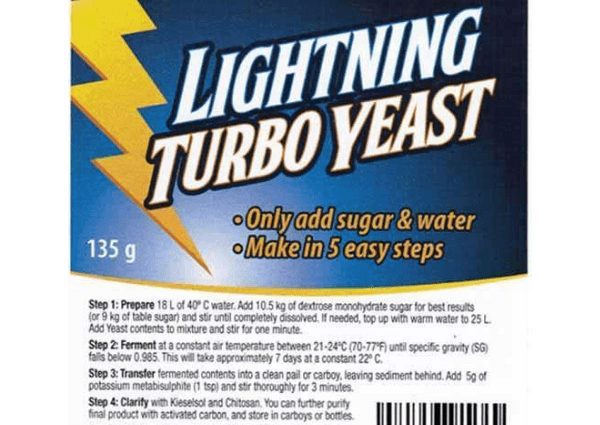Contents
For normal fermentation, yeast, in addition to sugar, needs micro- and macronutrients. In fruit and grain brews, these substances are present, although not in optimal quantities. The most difficult thing is with sugar mash, where there is nothing else besides water, oxygen and sugar. Too long fermentation worsens the organoleptic properties of the future drink, and the yeast produces more harmful impurities. However, very fast fermentation is also not always good, we will consider this situation further. Also, turbo yeast has a few more nuances of application.
Previously, to speed up the fermentation, moonshiners used home-made dressings for mash from ammonium sulfate and superphosphate. For example, ammonia, chicken manure, nitrophoska and others, sometimes malt and black bread were added. With the growing popularity of home brewing, yeast manufacturers proposed their own solution to the problem, which they called “turbo”.
Turbo Yeast are common alcohol yeast strains that come with nutritional supplements. It is due to top dressing that yeast multiplies faster, grows, processes sugar and has a high tolerance to alcohol, which makes it possible to obtain stronger home brew. For example, if on ordinary yeast the strength of the mash is not higher than 12-14%, then with turbo yeast it is really possible to add up to 21% alcohol content.
At the same time, it is important to remember that the strength of the mash depends on the sugar content, and turbo yeast can only process a higher concentration of it, when the usual ones already stop (bad), but cannot create alcohol from nothing.
Turbo yeast first appeared in Sweden in the 1980s, the author of the first nutritional supplement is Gert Strand. A few years later, other manufacturers created more effective mixtures. English brands are now leading the turbo yeast market.
Advantages and disadvantages of turbo yeast
Advantages:
- high fermentation rate (1-4 days compared to 5-10 days for conventional yeast);
- the opportunity to get stronger mash (up to 21% vol. compared to 12-14% vol.);
- stable fermentation.
Disadvantages:
- high price (on average, turbo yeast for moonshine is 4-5 times more expensive than usual);
- too fast fermentation rate (1-2 days) increases the concentration of harmful substances;
- often incomprehensible composition of top dressing.
Most manufacturers do not list the exact composition of turbo yeast, limiting themselves to describing that the product includes a dry yeast strain, nutrients, vitamins and trace elements. There is always a risk that the composition does not contain the most useful substances for the human body, especially since their concentration is incomprehensible.
Types of turbo yeast for moonshine
Sugar, fruit and grain brews require different varieties of yeast and top dressing.
Turbo yeast for grain brews may contain the enzyme glucoamylase, which breaks down complex sugars into simple ones, which speeds up the work of the yeast. Also, some manufacturers add activated charcoal to absorb harmful substances, but the effectiveness of this solution is doubtful due to the small amount of charcoal and its limited ability to clean mash.
The presence of glucoamylase in the composition does not eliminate the need to saccharify starch-containing raw materials using a hot or cold method. Some turbo yeasts contain the enzymes amylosubtilin and glucavamorin, which cold saccharify raw materials. Turbo yeast instructions should state if saccharification is required.
Turbo yeast for fruit brews usually additionally contains the enzyme pectinase, which destroys pectin, which contributes to better separation of juice and less methyl alcohol, and mash with a low pectin content clarifies faster.
Turbo yeast for sugar mash has the simplest composition, because in this case you do not need to take care of preserving the aroma and taste, the moonshiner has only one task – to get the purest neutral alcohol or distillate.
It is important to remember that most turbo yeast is designed specifically for moonshine. Producers expect that the remaining substances from top dressing will be removed during distillation or rectification, and for wine you need to buy special types. Turbo yeast for wine must have a safe top dressing, because some of the micro and macro elements will remain in the wine forever and will be drunk by a person. You can make moonshine with wine yeast, but the reverse substitution (wine with turbo yeast for moonshine) is not recommended. Personally, for safety reasons (composition and concentration of substances are unknown), I do not use turbo yeast for making wine.
Application of turbo yeast
Instructions for turbo yeast should be printed on the packet and should be followed because different strains and top dressings have different requirements.
Only a few general recommendations can be made:
- when buying, check the expiration date and integrity of the package. Turbo yeast must be supplied in a bag of thick laminated film with an inner foil layer, any other packaging will significantly reduce the shelf life;
- strictly adhere to the temperature regimes indicated in the instructions (usually 20-30 ° C), otherwise the yeast will die due to too high a temperature (very important if the volume of mash is more than 40-50 liters, because fermentation of such a volume in itself raises the temperature) or stop because it is too low;
- it is advisable to clarify the mash on turbo yeast before distillation in order to precipitate the maximum of substances from top dressing;
- An opened package of turbo yeast can be stored for 3-4 weeks in the refrigerator, after removing the air from it and sealing it tightly.










